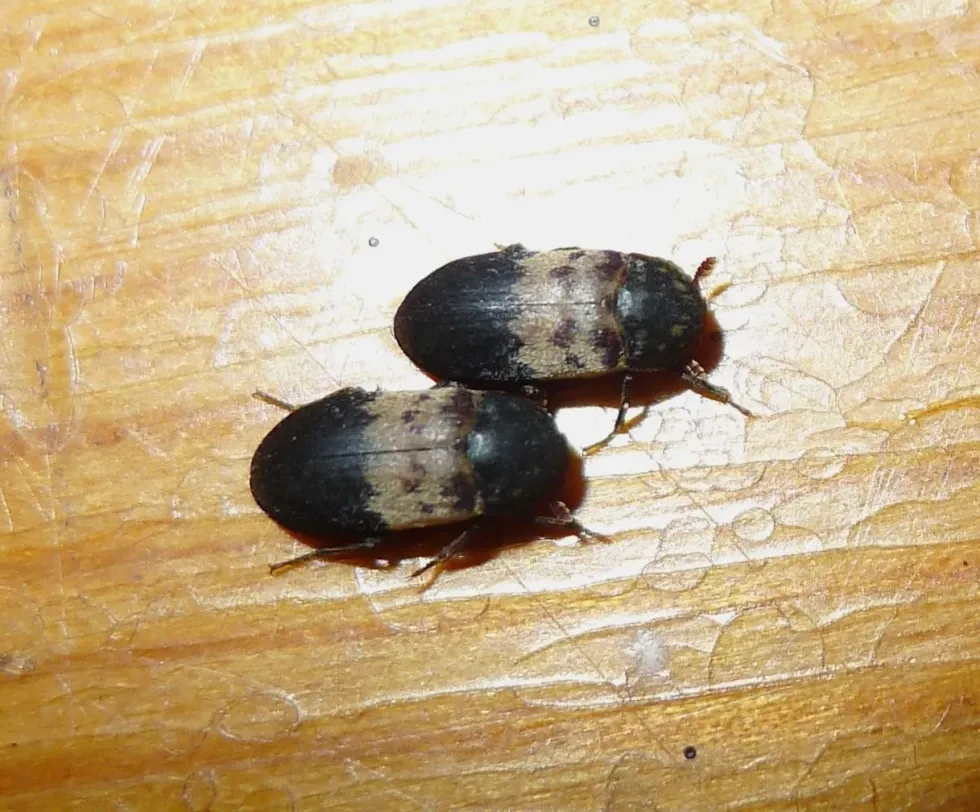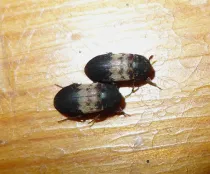Larder Beetles (Dermestes lardarius) or moisture bugs are the most common form of household bugs found industrially and commercially in places that process flesh, meat, and raw proteins.
These beetles are used in forensics and museums as they can clean out the flesh and the carcasses of dried dead animals and insects. They can process complex proteins efficiently. They get into cracks and crevices quickly and are found in both commercial and non-commercial spaces.
They are large and oval. They are black and have a tan-yellow band across the body.
They are known to enter homes during summer and fall (hence the name 'moisture bugs'), and they leave during winter. When they gather in large groups of hundreds to thousands, they can cause insane amounts of damage.
While pupating, they have a habit of boring holes in wooden structures and doors to find a safe place to pupate, like food, insulation, and books.
To find out more interesting facts and information about other animals. You can also check our longhorn beetle facts and dung beetle facts for more enriching and mind-blowing facts and guides.
Larder Beetle Interesting Facts
What type of animal is a larder beetle?
A larder beetle (Dermestes lardarius) is a species of beetle also known as moisture bug, leather beetle, and carpet beetle. They are known to be one of the most common pests of cured and dried meat products, stored food, pet food, dead insects, and almost all things known to be their food.
What class of animal does a larder beetle belong to?
Larder beetle is a common pest in households, and they belong to the class of Insecta (the largest group within the arthropod phylum).
How many larder beetles are there in the world?
There are many larder beetles worldwide as they are found worldwide in abundance and are used commercially and forensically. Their exact number is not determined yet, and the same would be a mammoth task since they reproduce so rapidly.
Where does a larder beetle live?
Larder beetles and larder beetle larvae are present almost worldwide; they are usually termed household pests, easily found in residential areas. They are also found in commercial places.
In houses, they can easily be found anywhere and particularly in kitchen pantries. Adult larder beetles can also be found in industrial areas as they are used to process animal proteins. They are found worldwide.
What is a larder beetle's habitat?
Adult larder beetles and larder beetle larvae are common pests for many commercial and industrial sites where animal protein is stored and processed. Larder beetles may also be found in household items, namely, stored food, food products, cheese, dead insects, pet food sources, animal products, plant materials, wood, attic walls, basements, crawl spaces, cracks, and crevices.
They are also used in museums to clean animal carcasses and flesh.
Who do larder beetles live with?
Larder beetles live in large groups and lay eggs together on any appropriate surface or place for larder beetle infestation.
How long does a larder beetle live?
The eggs take two weeks to hatch, and the larder beetle larva takes around 40-50 days with a high protein diet and starts pupating into an adult larder beetle. The total life cycle for beetle larvae to turn into adult larder beetles is around two months.
How do they reproduce?
Females lay eggs (over 100 eggs) in food sources and food products that they find for their larvae throughout the summer after the mating season. The larvae turn into adults in around 40-50 days, and then the pupal stage ends in three to seven days, and the life cycle of a larder beetle is thus completed.
What is their conservation status?
There are many larder beetles worldwide in abundance, and they are used in industrial and commercial settings; thus, they fall under the category of Least Concern.
Larder Beetle Fun Facts
What do Larder Beetles look like?
Adult larvae beetles are dark brown to black. The frontal portion with the wing covers has a hardened case (also dark brown).
A yellow band on the wing covers itself with pale yellow hair strands and dark spots (of dark brown) all over. Their underbelly and legs are covered with fine yellow hair strands.
Larder beetle larva looks like a worm and is densely covered with reddish-brown hair all over its body. larder beetle larvae have two curved spines on the last segment of their body that can curve backward.
How cute are they?
Larder beetles are not cute at all. They can even be disgusting to a few. Their eggs are laid in huge quantities, and they hatch real quick. A larder beetle infestation can be a big issue for any household.
How do they communicate?
There is no specific information regarding how larder beetles communicate, but it is believed that larder beetles communicate through chemicals and vibrations, like other beetles.
How big is a larder beetle?
Larder beetles are pretty small in size and can be approximately 0.27-0.35 in (7-9 mm) in length, making them even smaller than an average-sized coin.
How fast can larder beetles move?
Larder beetles are known to move quite fast and hide in cracks and pores, holes, or any food source. Their exact speed is not known.
How much does a larder beetle weigh?
There is no specific information on how much larder beetles weigh.
What are the male and female names of the species?
There is no specific name for male and female larder beetles.
What would you call a baby larder beetle?
Baby larder beetles can be called larvae or grubs. They generally look like a worm when they hatch from their eggs.
What do they eat?
Larder beetles can eat almost anything ranging from food items, food material, animal food, dead insects, and dried insects. They also consume any food source like stored food, pet food, meat, animal products, cheese, proteins, plant material, wood, woolen things, fur, and feather.
Are they harmful?
The beetle is known as a common household pest, but it is not harmful to humans. These beetles can bite humans (known as the larder beetle bite), and this bite isn't fatal.
Would they make a good pet?
They are not good pets, though they are used in industries for commercial purposes. Rearrange the word 'pets', and you'll know exactly what they are. You're right, they're a pest! They only waste and infest food items in their homes. Their infestation is known to be one of the biggest problems for pest control agencies.
Did you know...
To prevent larder beetles and their larvae, one should try to stop their life cycle before the pupating period, which can be done by keeping their food source secure and in air-tight containers. Use the method of exclusion to get rid of them and their larvae. You can also call a pest control agency.
Are you wondering, 'Why are there larder beetles in my house?' They hunt down the carcasses of dead animals and insects. Make sure to get to the root cause and get rid of it.
What causes larder beetles?
Larder beetles can come into your house for many reasons as they are perpetually hungry. Be it the larvae or an adult, they can eat almost anything from stored food items, cereal, or any other food source.
They will contaminate your food items, make holes in wooden surfaces and doors and destroy things.
To get rid of these, the best tool one can use to kill this pest of a beetle is pesticides. If you see any holes or signs of larvae or adults of this beetle on any food surface or wooden surface, then it's time to stop their infestation.
How to get rid of larder beetles?
The best way to get rid of them is exclusion and the use of different pesticides. It is also best to call a pest management agency to find additional infestation sites by the larvae and adults.
Here at Kidadl, we have carefully created lots of interesting family-friendly animal facts for everyone to discover! For more relatable content, check out these cockle facts or tiger beetle facts.
You can even occupy yourself at home by drawing one on our larder beetle coloring pages.









